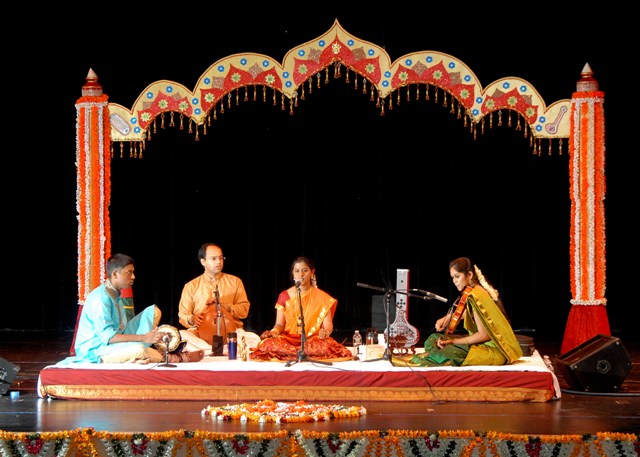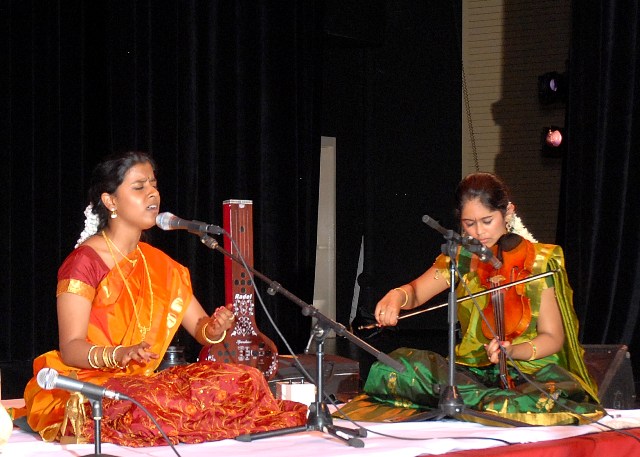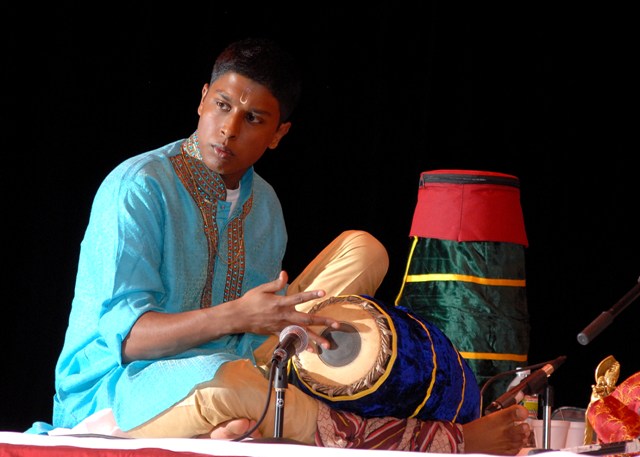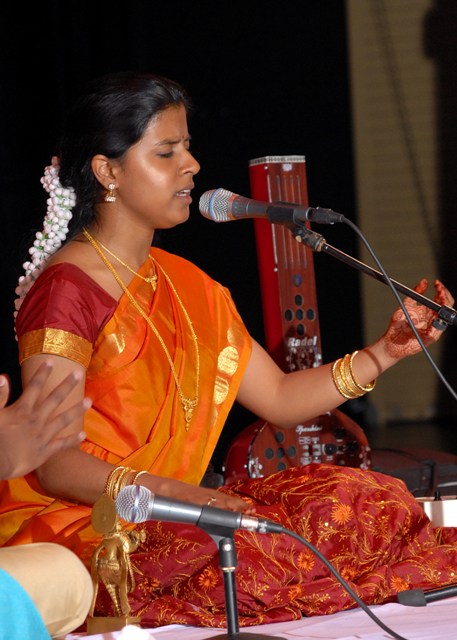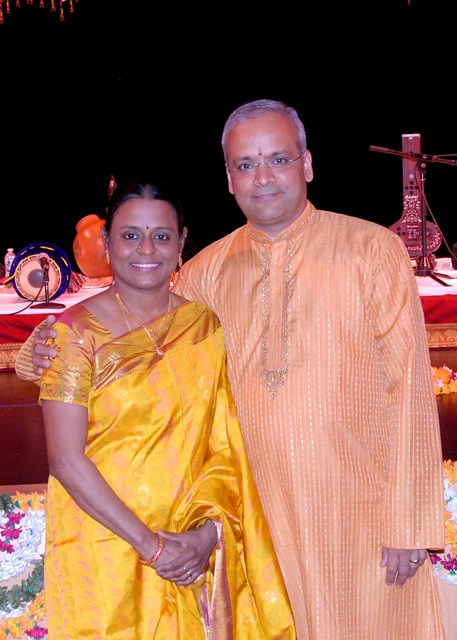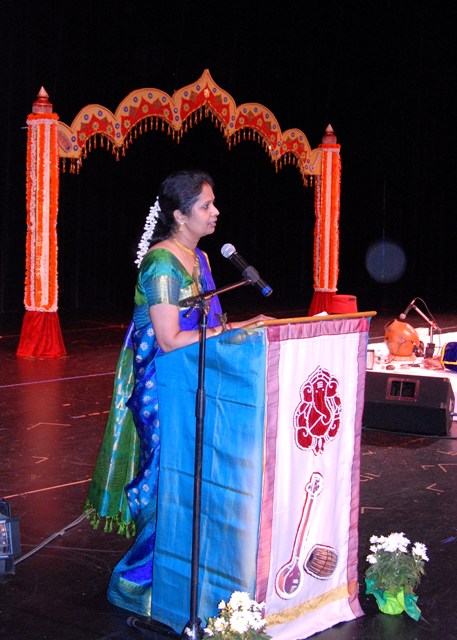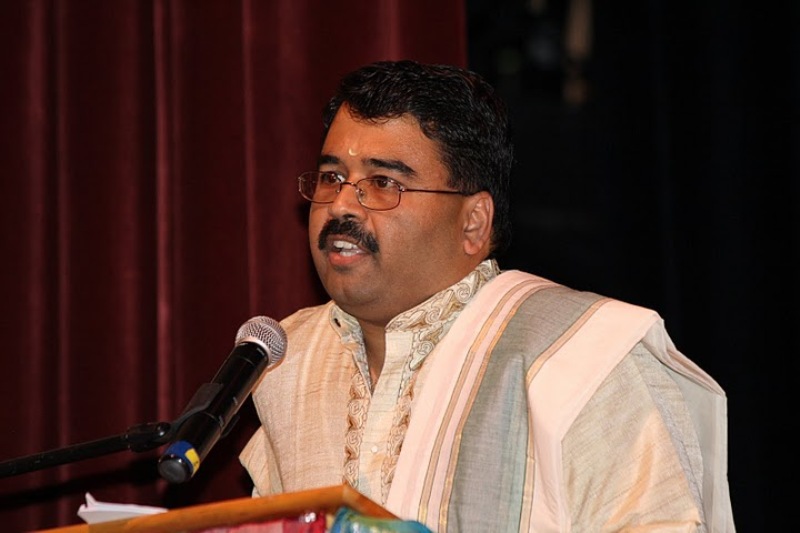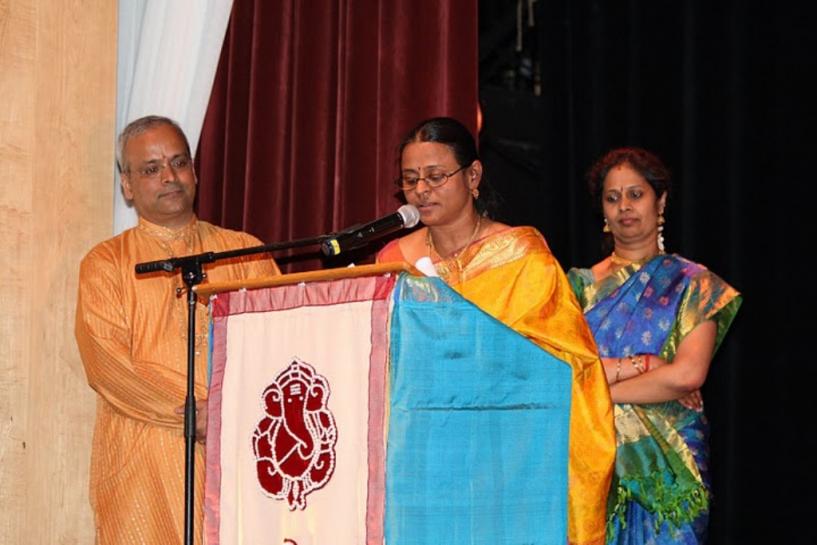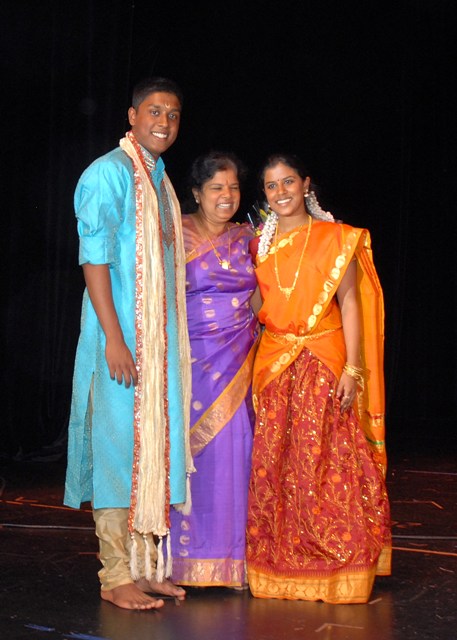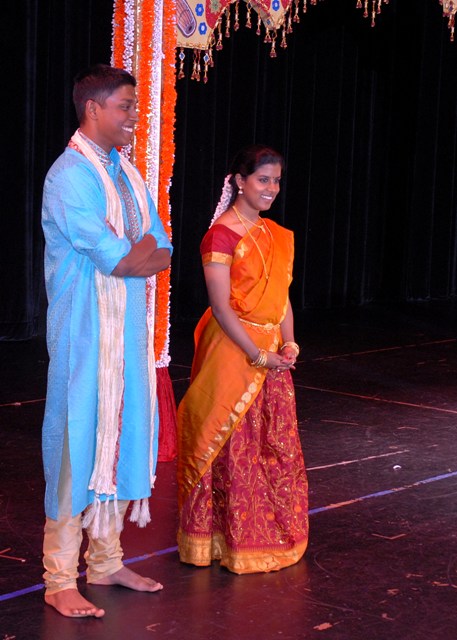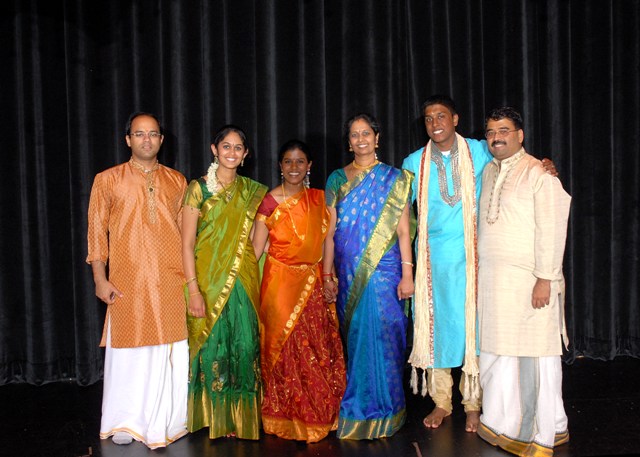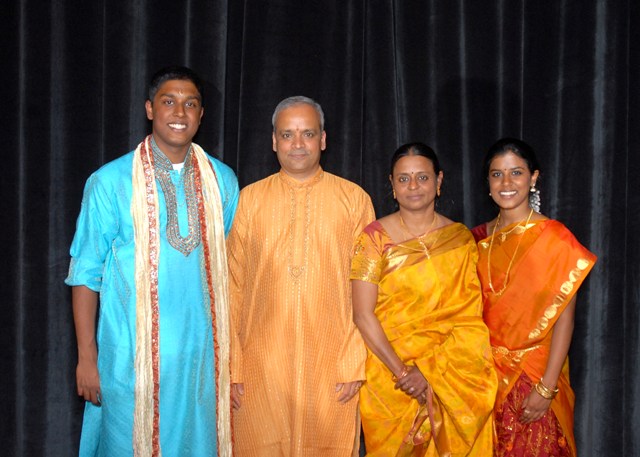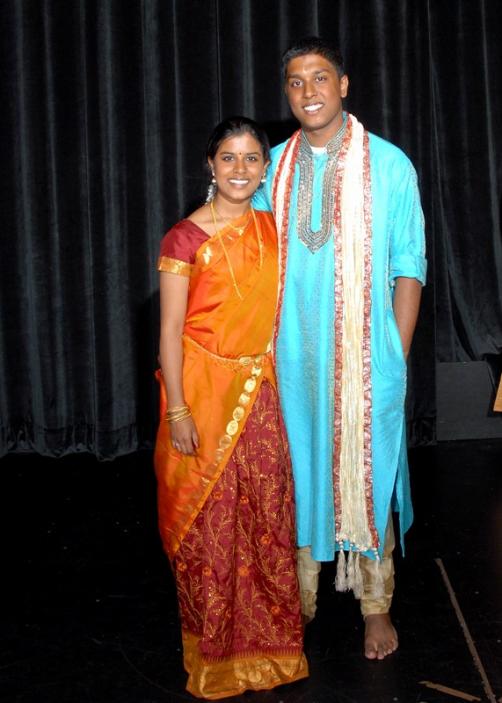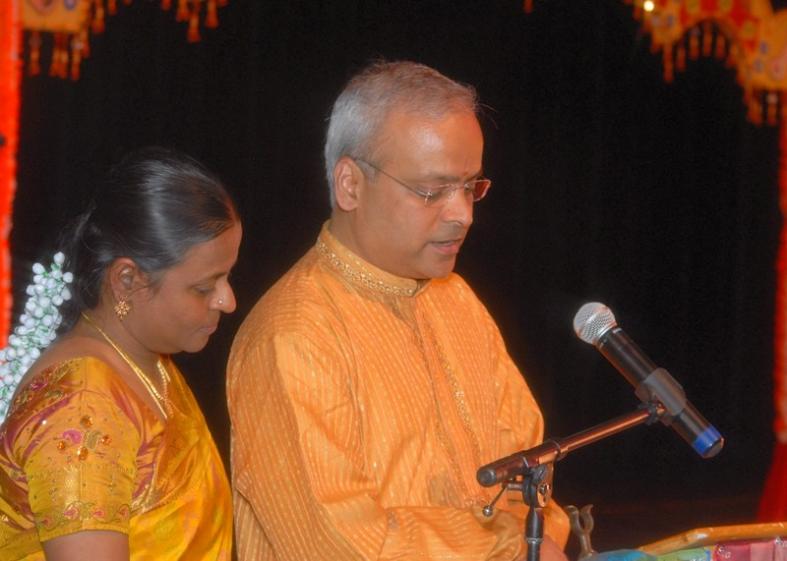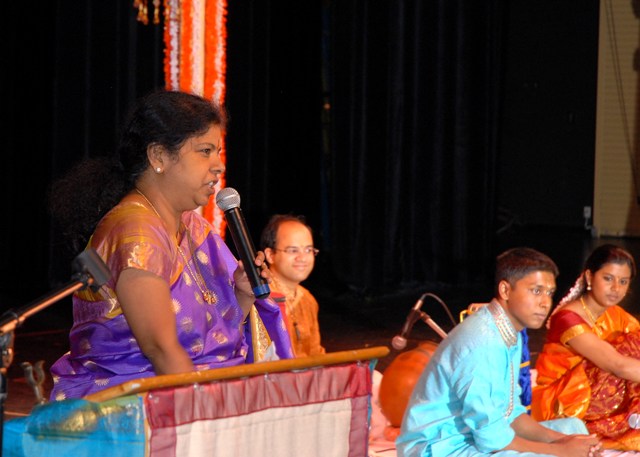Contribute
| Twin Treats Of Tradition – Vocal And Mridangam Arangetram |
K.V.S Vinay
07/18/2011
Nestled in the quiet suburb of Easton, the beautiful performance center at the Oliver Ames High School was the location for an unusual, if not unprecedented, Carnatic music event. Twin siblings Divya and Varun Chandramouli presented a joint arangetram (debut performance) with a very fulfilling performance. Divya presented a vocal recital for over three hours accompanied by Varun on the mridangam, Kum. Rasika Murali on the violin and Dr. Ravi Balasubramaniam on the ghatam.
In his composition “Ni Chittamu†(Dhanyasi), Sri Thyagarajaswami says that the Guru is the “chillaginja†(a soap-like nut) that cleanses or polishes. Throughout the concert, the sheen imparted by the gurus certainly showed in the performance of the students. Blessed with a sweet and pliant voice, Divya has fully imbibed Guru Geetha Murali’s hallmark bhava in rendering of compositions. Varun, a disciple of Guru Mahalingam Santhanakrishnan, showed that he has carefully learnt his guru’s style of understanding and embellishing a composition rather than simply playing along.
The opening piece, a challenging Dharu Varnam in Khamas (“Matheâ€) composed by Sri Muthaiah Bhagavathar, was well rendered, with the swara, lyric and jati in Mukthayi Swaram being presented in two speeds. “Omkara Rupane, Ganapate†in Mohanam, a composition of Smt. Kamala Krishnamurthy was rendered briskly. Here Divya showed good grip on laya by rendering swaras at the spot before the samam, or the landing spot of the song. This was followed by a soulful rendition of “Karunanidhiye Taayeâ€, Sri Papansam Sivan’s composition in Bowli. Varun displayed great sensitivity and intelligence by ending this song with a “poruttam†(a mathematical pattern matching the lyrical setup of the song) korvai.
Sri Subbaraya Sastri is known to have learnt from all three of the Carnatic Trinity and his compositions thus reflect an amalgam of Sri Thyagaraja’s elegant raga essence, Sri Dikshitar’s handling of language and Sri Syama Sastri’s emotive appeal. The debutants’ next choice, “Sankari Neeve†(Begada) is an outstanding example of this heady blend. The song, preceded by a brief alapana, was competently rendered. Once again Varun showed his knowledge of the song in accompanying the chittaswaram patterns to perfection. Divya’s ending korvai very intelligently employed the variations on the raga’s key vadi-samvadi phrases of Ma Ga Ri Sa / Ni , Da Pa.
Smt. M.S. Subbulakshmi’s version of “Rangapura Vihara†(Brindavansaranga, Sri Muthuswami Dikshitar) is the current gold standard for this composition. With her involvement and bhava, Divya did full justice to this composition and the version. Next in line was Smt. Ambujam Krishna’s “Om Namo Narayanaâ€. Tuned by Smt. Charumathi Ramachandran in the brigha-heavy Karnaranjani, this song was a brisk contrast to the gamaka heavy Begada and Brindavana Saranga.
With the stage set for the main piece, Divya and Rasika delved into the depths of Madhyamavathi. Divya’s opening phrase established the raga in clear terms. It was then developed in a leisurely fashion with requisite importance being given to all key pausing points (jeeva swaras) of the ragas and ending with fast phrases in a cadence-like pattern. Notably, Divya displayed the prowess of her voice by hitting the Ni in the third octave with great ease. Sri Thyagaraja’s “Rama-Katha Sudha†was a very apt follow up to the elaborate alapana. Both the niraval and kalpanaswaram at “Bhama Mani Janaki†had a very good build up and ending. In particular the last swaram was developed in a leisurely and expansive fashion that is more often seen in concerts of seasoned artistes.
In the tani avartanam, presented in the company of Sri Ravi Balasubramaniam, Varun amply demonstrated his level of technical preparation. His korvai in the opening sequence was a blend of the Chatusram and Tisra nadais. After the return from Sri Ravi, Varun delved into a detailed exposition of Tisra Nadai. The Kuraippu (reduction-before-finale) section had interesting exchanges between the percussionists including interesting variations of the Misra Kuraippu being executed flawlessly by Varun.
The brisk “Kapaalini Dayanidhi†(Palini, Smt. Lalitha Sivakumar) warmed up the artistes and audience for the Ragam, Tanam, Pallavi (RTP) section of the concert. Lathangi, the 63rd Melakartha, was the chosen raga. Once again the raga was rendered with due justice to all the key phrases by Divya and Rasika. The brisk tanam was well enhanced by the double string bowing of Rasika. The Pallavi was set to Adi talam and dedicated to Lord Hanuman. With an eduppu of 3 from samam and a karavi of 5 the challenging pallavi’s deceptively easy sounding rendition was a testament to the artistes’ hard work. The trikalam and tisram was well rendered from the arudhi. The ragamalika in Hindolam, Sahana, Madhuvanti and Kanada was joyfully sung in 1-kalai with Divya doing a reverse trek back to Lathangi in the finale.
The ragamalika piece “Shiva Rama Krishna†offered a good transition into the tail end of the concert. Sri Purandara Dasa’s “Hari Smarane Mado†was high on emotive appeal. The bhajan-like “Krishna Krishna†section drew much appreciation from the audience. The lilting Dhanashri tillana of Sri Swathi Tirunal and Thyagaraja’s Mangalam were fitting finale to the concert which received a huge applause from the audience.
Divya and Varun’s performance was significantly embellished by the outstanding violin accompaniment of their “buddyâ€, Rasika Murali. Her innate talent and training from her gurus (Smt. Geetha Murali and Smt. Tara Anand) have shaped her in to an accomplished musician. Rasika used excellent sound modulation to present highly vocalized version of raga alapanas, niraval and swaram. It was also great to see the camaraderie between the three friends.
Special mention needs to be made of Dr. Ravi Balasubramanian. As is his style in arangetrams, he was unfailingly supportive of the young talent and highly understated in the display of his ample brilliance. As a top ranking ghatam artiste and an Ivy League academican, Ravi is a role model for all of today’s youngsters for managing time to develop one’s art to high levels along with a very busy career.
The proud Gurus Smt. Geetha Murali and Sri Mali should be congratulated for planning and executing this program. Having two debutants on stage is no easy task. Each aspect was well planned including the choice of korvais and especially the song list which had only one Thyagaraja kriti and showcased three women composers.
Congratulations to the parents Bhuvana and Chandramouli and all the tireless volunteers who probably missed some of the concert to stay on top of arrangements. This is your success as well!
Lastly, I would like to point out that this arangetram was also unusual in another respect. Unlike most debutants Varun and Divya are already in college. As Ravi Balasubramaniam once mentioned in an interview, college is the most likely time to lose touch with art due to additional responsibilities and lack of support structure for practicing music. To find time to come back regularly for classes, practice and prepare a concert of this caliber speaks of immense dedication and interest on part of Varun and Divya.
Great job Varun and Divya! We hope you will continue to keep this passion for music or even find ways to incorporate into your professional lives as a doctor and historian respectively! Best wishes for the future.
You may also access this article through our web-site http://www.lokvani.com/
